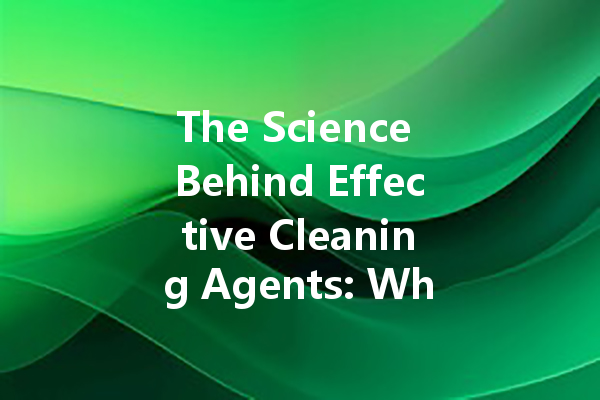Cleaning agents are essential products that help keep our homes, workplaces, and public spaces free from dirt, germs, and unwanted odors. Understanding the science behind these agents can help us choose the most effective options for our needs, while also considering their impact on health and the environment. In this article, we’ll explore the foundations of effective cleaning agents, their key ingredients, and eco-friendly alternatives.
Understanding the Basics of Cleaning Agents
Cleaning agents, also known as cleaners or detergents, are substances designed to remove dirt, stains, and bacteria from surfaces. The efficacy of a cleaning agent depends on its ability to interact with contaminants, breaking them down or suspending them. Most cleaning agents fall into four main categories: soaps, detergents, solvents, and acids.
Key Ingredients That Make Cleaning Agents Effective
The effectiveness of cleaning products derives from their specific ingredients. Below are some common components found in many cleaning agents and how they work:
Surfactants
Surfactants are the primary active components in both soaps and detergents. They reduce the surface tension of water, allowing it to better penetrate and lift dirt and grease. Surfactants also help emulsify oils, making it possible to wash them away with water.
Enzymes
Enzymes are biological catalysts that speed up chemical reactions. In cleaning products, they break down proteins, fats, and carbohydrates, making it easier to remove stubborn stains, such as those from food or bodily fluids. Protease, lipase, and amylase are common enzymes used in laundry detergents.
Fragrances and Dyes
While not essential for cleaning effectiveness, many products include fragrances and dyes to improve user experience. Fragrances mask odors, making spaces smell better, while dyes can give products a visually appealing look. However, these ingredients may trigger allergies in some individuals, so it’s crucial to consider allergen-friendly alternatives.
Preservatives
To improve the shelf life of cleaning products, preservatives such as benzisothiazolinone or methylisothiazolinone are added to prevent microbial growth. While they are effective at extending product life, some people may be sensitive to these preservatives.
The Impact of pH Levels on Cleaning Effectiveness

The pH level of a cleaning agent influences its cleaning abilities. Most cleaning agents fall into three pH categories: acidic, neutral, and alkaline.
Acidic Cleaners
Acidic cleaners (pH less than 7) are effective for dissolving mineral deposits, rust, and other stubborn stains. They are commonly found in bathroom cleaners and toilet bowl cleaners.
Neutral Cleaners
Neutral cleaners (pH around 7) are gentle on surfaces and best for everyday cleaning tasks. They are less likely to damage surfaces and are typically used for mopping floors, cleaning countertops, and wiping down surfaces.
Alkaline Cleaners
Alkaline cleaners (pH greater than 7) are powerful grease-cutting agents. They are effective for cleaning kitchens, particularly for removing greasy residues from stoves and ovens.
Choosing Eco-Friendly Cleaning Agents
As environmental concerns rise, many consumers seek eco-friendly cleaning agents. These products typically contain plant-based ingredients and avoid harsh chemicals that can harm the environment and human health.
Natural Surfactants
Eco-friendly alternatives often use natural surfactants derived from coconut or palm oil instead of synthetic options. These plant-based surfactants provide similar cleaning power with a reduced environmental footprint.
Biodegradable Ingredients
When choosing cleaning products, look for biodegradable ingredients that break down naturally in the environment. This reduces pollution and minimizes the chemical burden on ecosystems.
Certification and Transparency
Consumers should opt for brands that provide transparent ingredient lists and possess eco-certifications, such as Green Seal or EcoLogo. These certifications indicate that the products adhere to strict environmental and safety standards.
Conclusion
Understanding the science behind effective cleaning agents empowers consumers to make informed choices. By recognizing the different types of cleaning agents, their key ingredients, and their environmental impact, we can select products that not only meet our cleaning needs but also align with our values. As the demand for eco-friendly solutions grows, both consumers and manufacturers play vital roles in advancing safer, greener cleaning practices.
